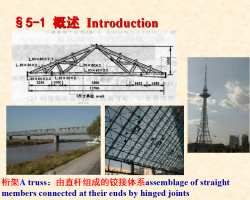桁架A truss:由直杆组成的铰接体系assemblage of straight members connected at their ends by hinged joints
基本假设:Basic assumptions
1、各结点为理想铰;all hinges are frictionless
2、各杆轴线为直线,所有用铰联结的杆交于铰心;The centroidal axes are straight lines,those meeting at a hinge all intersect at the centre of hinge.
3、荷载只作用于结点上。All loads are applied on truss only at its joints.
导出特性:各杆截面上只受轴力作用,而没有弯矩和剪力,这样的杆称为二力杆。All members are subjected only to
axial forces, but not subjected to bending moments and shear forces, these members are called two-force members.
桁架结构的分类Classification of trusses:
一、平面(二维)桁架(plane trusses)
所有组成桁架的杆件以及荷载的作用线都在同一平面内.
All the members and the applied loads lie in the a single plane.
二、按外型分类Classification according to their forms
平行弦桁架
Parallel chord trusses
2. 三角形桁架Triangular trusses
3. 抛物线桁架(折线桁架)Parabolic trusses
4. 梯形桁架Trapezoidal trusses













